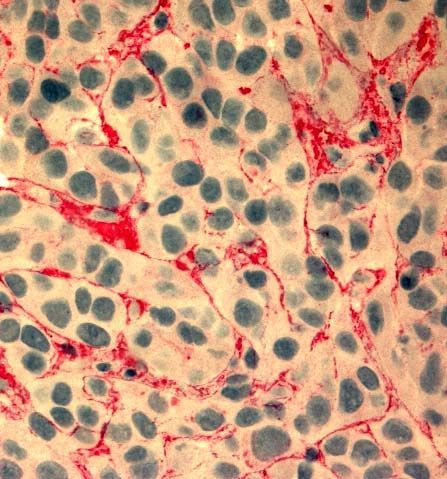anti-Fibronectin (EDA) mAb (blocking) (IST-9) (preservative free)
| Code | Size | Price |
|---|
| AG-20B-6001YPF-C100 | 100 ug | £270.00 |
Quantity:
| AG-20B-6001YPF-C500 | 500 ug | £660.00 |
Quantity:
Prices exclude any Taxes / VAT
Overview
Host Type: Mouse
Antibody Isotype: Mouse IgG1
Antibody Clonality: Monoclonal
Antibody Clone: IST-9
Regulatory Status: RUO
Target Species:
- Bovine (Cattle)
- Canine (dog)
- Chicken (Gallus)
- Human
- Monkey
- Mouse
- Porcine (pig)
- Rat
Applications:
- Blocking
- Enzyme-Linked Immunosorbent Assay (ELISA)
- Functional Study
- Immunocytochemistry (ICC)
- Immunohistochemistry (IHC)
- Western Blot (WB)
Shipping:
BLUE ICE
Storage:
Short Term Storage: +4°C. Long Term Storage: -20°C
Images
Documents
Further Information
Alternate Names/Synonyms:
FN; Cold-insoluble Globulin; CIG; Fibronectin (EIIIA)
Concentration:
Lot dependent
EClass:
32160000
Form (Short):
liquid
Formulation:
Sterile liquid. In 20mM sodium phosphate buffer, pH7.6 containing 150mM sodium chloride.
Handling Advice:
After opening, prepare aliquots and store at -20°C.Avoid freeze/thaw cycles.
Immunogen:
Recombinant Extra Domain A (EDA) region of human cellular fibronectin.
Labels - Conjugates:
Preservative Free
Long Description:
Monoclonal Antibody. Recognizes an epitope located in the EDA sequence of human cellular fibronectin (FN). Does not detect extracellular FN (plasma FN). Cross-reacts with mouse, rat, monkey, pig, dog, cow and chicken fibronectin EDA (according to literature). Isotype: Mouse IgG1. Clone: IST-9. Applications: ELISA, FUNC (Blocking), ICC, IHC, WB. Liquid. In 20mM sodium phosphate buffer, pH7.6 containing 150mM sodium chloride. Fibronectin is a major component of the extracellular matrix that binds to integrins, cell surfaces and various compounds including collagen, fibrin, heparin, DNA and actin. It occurs in two main forms: plasma and cellular fibronectin. EDA (Extra Domain A)-containing cellular fibronectin (EDA-FN) plays a major role in cell adhesion, growth, migration and differentiation and it is important for processes such as wound healing and embryonic development. It is associated with fibroblast differentiation by increasing alpha-SMA expression, collagen deposition, cell contractility and focal adhesion kinase (FAK) activation. EDA-FN promotes cell spread by interacting with the integrins alpha5-beta1, alpha4-beta1 and alpha9-beta1 and has been shown to promote angiogenesis, lymphangiogenesis and metastasis of colorectal tumors. In transformed or tumor-derived cells the EDA segment is about 10-times higher than in fibronectin from normal fibroblasts and it may therefore be a significant marker for malignancy.
Package Type:
Plastic Vial
Product Description:
Fibronectin is a major component of the extracellular matrix that binds to integrins, cell surfaces and various compounds including collagen, fibrin, heparin, DNA and actin. It occurs in two main forms: plasma and cellular fibronectin. EDA (Extra Domain A)-containing cellular fibronectin (EDA-FN) plays a major role in cell adhesion, growth, migration and differentiation and it is important for processes such as wound healing and embryonic development. It is associated with fibroblast differentiation by increasing alpha-SMA expression, collagen deposition, cell contractility and focal adhesion kinase (FAK) activation. EDA-FN promotes cell spread by interacting with the integrins alpha5-beta1, alpha4-beta1 and alpha9-beta1 and has been shown to promote angiogenesis, lymphangiogenesis and metastasis of colorectal tumors. In transformed or tumor-derived cells the EDA segment is about 10-times higher than in fibronectin from normal fibroblasts and it may therefore be a significant marker for malignancy.
Product Line Areas NEW:
Cancer, Immunology, Inflammation, Antibodies
Purity:
>95% (SDS-PAGE)
Source / Host:
Purified from concentrated hybridoma tissue culture supernatant.
Specificity:
Recognizes an epitope located in the EDA sequence of human cellular fibronectin (FN). Does not detect extracellular FN (plasma FN). Cross-reacts with mouse, rat, monkey, pig, dog, cow and chicken fibronectin EDA (according to literature).
Transportation:
Non-hazardous
UNSPSC Category:
Primary Antibodies
UNSPSC Number:
12352203
Use & Stability:
Stable for at least 1 year after receipt when stored at -20°C.
References
Monoclonal antibodies in the analysis of fibronectin isoforms generated by alternative splicing of mRNA precursors in normal and transformed human cells: L. Borsi, et al.; J. Cell Biol. 104, 595 (1987) | Localization of the cellular-fibronectin-specific epitope recognized by the monoclonal antibody IST-9 using fusion proteins expressed in E. coli: B. Carnemolla, et al.; FEBS Lett. 215, 269 (1987) | Molecular and immunologic differences in canine fibronectins from articular cartilage and plasma: N. Burton-Wurster & G. Lust; Arch. Biochem. Biophys. 269, 32 (1989) | Coordinate oncodevelopmental modulation of alternative splicing of fibronectin pre-messenger RNA at ED-A, ED-B, and CS1 regions in human liver tumors: F. Oyama, et al.; Cancer Res. 53, 2005 (1993) | Endogenous fibronectin of blood polymorphonuclear leukocytes: immunochemical characterization and subcellular localization: R. Salcedo, et al.; Exp. Cell Res. 233, 25 (1997) | The fibronectin domain ED-A is crucial for myofibroblastic phenotype induction by transforming growth factor-beta1: G. Serini, et al.; J. Cell Biol. 142, 873 (1998) | Identification of two amino acids within the EIIIA (ED-A) segment of fibronectin constituting the epitope for two function-blocking monoclonal antibodies: Y.F. Liao, et al.; J. Biol. Chem. 274, 17876 (1999) | Engagement of alpha4beta7 integrins by monoclonal antibodies or ligands enhances survival of human eosinophils in vitro: J. Meerschaert, et al.; J. Immunol. 163, 6217 (1999) | Segmental antigen challenge increases fibronectin in bronchoalveolar lavage fluid: J. Meerschaert, et al.; Am. J. Respir. Crit. Care Med. 159, 619 (1999) | Deletion of the alternatively spliced fibronectin EIIIA domain in mice reduces atherosclerosis: M.H. Tan, et al.; Blood 104, 11 (2004) | Fibronectin-alpha4beta1 integrin interactions regulate metalloproteinase-9 expression in steatotic liver ischemia and reperfusion injury: C. Moore, et al.; Am. J. Pathol. 170, 567 (2007) | Identification of the peptide sequences within the EIIIA (EDA) segment of fibronectin that mediate integrin alpha9beta1-dependent cellular activities: A.V. Shinde, et al.; J. Biol. Chem. 283, 2858 (2008) | Fibronectin extra domain A (EDA) sustains CD133+/CD44+ subpopulation of colorectal cancer cells: J. Ou, et al.; Stem Cell Res. 11, 820 (2013) | Irigenin, a novel lead from Western Himalayan chemiome inhibits Fibronectin-Extra Domain A induced metastasis in lung cancer cells: A. Amin, et al.; Sci. Rep. 6, 37151 (2016) | Detection of soluble ED-A+ fibronectin and evaluation as novel serum biomarker for cardiac tissue remodeling: B. Ziffels, et al.; Dis. Mark. 2016, ID3695454 (2016)



